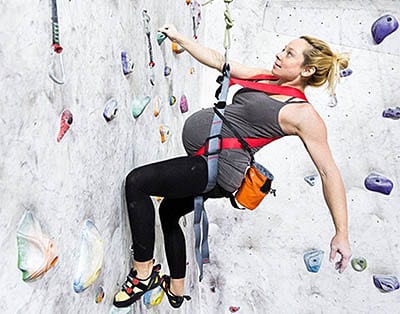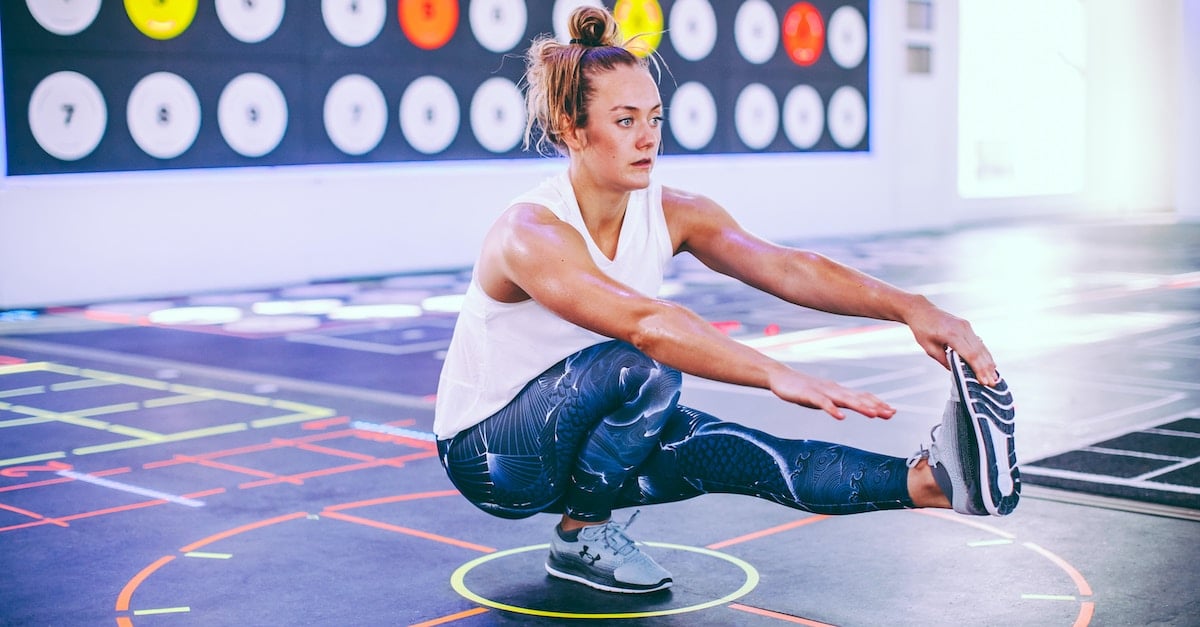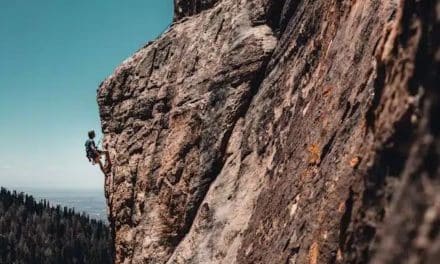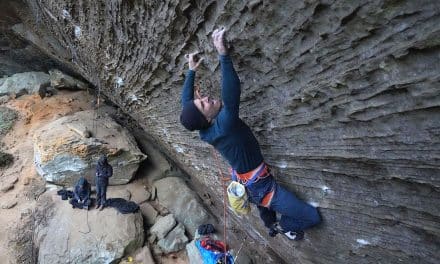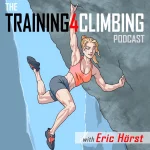Should you continue to climb while pregnant? With an ordinary pregnancy, the answer is an emphatic “yes!” In this article, Dr. Nicole Bringer presents important training tips and safety guidelines for climbing pregnant.
(This article was originally published in January of 2020 and has been updated to stay in line with current medical recommendations.)
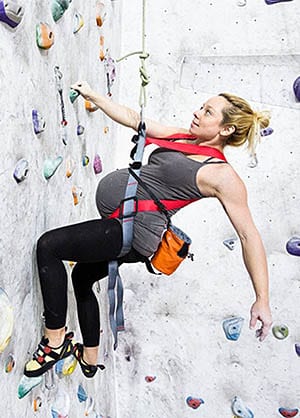
So what’s a mama climber to do? It’s possible to keep up your climbing habit through pregnancy and beyond, so long as you adjust for the inevitable changes your body will experience.
Challenges of Climbing Pregnant
Pregnancy is a unique and jarring experience for women, especially those of us who enjoy athletic activities like climbing. As climbers, we have specific training goals within climbing, as well as those that go beyond those climbing workouts specifically to include healthy nutrition habits, cardio and strength training, and mental performance. Pregnancy threatens all of these goals.
During pregnancy, women can expect to gain 25-30 pounds. Our core system—made up of not only our deep abdominals (transverse abdominis) and back muscles (multifidi), but also our pelvic floor and diaphragm—stretches and weakens as a result of this weight gain during pregnancy. At least 66% of women experience a separation of the six-pack muscles (rectus abdominis) by the third trimester of pregnancy.
Pregnancy also disrupts our sleep patterns and energy levels. After our babies are born our nutrition needs change once again, especially when we breastfeed. If you’ve had a cesarean delivery, then you’re looking at ad additional six weeks of lifting and activity restrictions along with significant trauma to the abdominal muscles that used to provide stability and support.
At first glance, the obstacles women face during pregnancy and postpartum recovery can make it seem like climbing while pregnant is like bouldering with a fresh manicure—not a smart combo. As a Physical Therapist, climber, and mama myself, however, I would disagree!
Benefits of Climbing Pregnant
While it’s true that the goals of climbing will change (at least for a time) I’d argue that the physical perks, community, and enjoyment climbing brings make it a great activity for expecting and recovering moms.
Climbers need amazing core strength to allow them to create body tension and stick close to the wall to provide stability. Expecting mothers need to train their cores to make delivery easier and shorten their postpartum recoveries. Climbers also need strength in the shoulders and arms, especially when it comes to movements like gastons and mantles. Women who hope to labor and/or deliver on hands and knees need strong arms and shoulders to do so!
Not only was I preparing for labor and delivery and improving my postpartum recovery time by training during pregnancy, but I was training for climbing as well by maintaining forearm and finger strength. After all, I was basically climbing with a “weighted vest” of sorts. Fine-tuning my technique also became a priority, because muscling my way through routes was no longer an option. Maybe the in-utero experience might even jumpstart my little’s climbing skills; 2040 Olympics here we come!
Further, being able to move the body in familiar ways and connect with others eases the mental strain that expecting mothers experience throughout this tumultuous time. It’s important to remind yourself of what you are capable of, rather than fixate on what you no longer are. For those of us who have been climbing for a large portion of our lives, maintaining this link to who we are and what we love is integral to our mental health.
Safety Considerations
Keeping both baby and mom safe must remain top of mind throughout pregnancy. To begin with, here are two vital rules:
- Always use a full-body harness to avoid pressure on the abdomen.
- Avoid situations that could result in trauma to your belly. This takes lead climbing and bouldering off the table!
Expecting moms should also limit the risk of injury by exhaling with exertion to avoid excessive pressure build-up in their abdomens or pelvic floors. Too much pressure could lead to diastasis recti and incontinence. This is also a great time to focus on leading with your feet because hanging on your arms without the support of your feet can cause doming of your abdomen. The doming tells you that you aren’t managing abdominal pressure well, and could increase your risk for abdominal separation (large diastasis recti) which will make postpartum recovery a lot more difficult.
Post-Pregnancy Training Tips
Rest, recovery, and bonding with your newborn must take precedent during postpartum recovery. But for you mamas that might have a hard time taking an extended break from your training, I have a few tips to get you back up and at ’em sooner rather than later. First, I recommend postpartum moms start breathing exercises, pelvic floor recovery, and transverse abdominis strengthening within a week of delivery. As your body heals and you begin tolerating everyday tasks like walking, lifting your baby, and carrying groceries without pain, then can you slowly progress back to the gym.
Start with shorter training sessions and gauge your progression based on how your body tolerates the activities. Don’t skip the basics of core strengthening, improving flexibility, and addressing traumas from birth before you get back on the wall.
Take advantage of hangboards when returning to training since they can be used at home during naptime or after baby goes to bed. However, some hangboard routines include lots of core activation that you may not be ready for. For example, pull-ups or hanging with dynamic movement of your legs post particular challenges because they often result in doming or coning of the stomach muscles if your core is still weak. This doming can actually slow the healing of the abdominal separation that many women experience after pregnancy. Use caution in these scenarios.
Finally, reach out to Women’s Health Physical Therapists as a resource for recovering mamas. Pain management, musculoskeletal recovery and strengthening are our areas of expertise!
Climbing isn’t just for the dirtbags. This sport offers so much benefit to mothers and families because it encourages time outdoors, promotes exercise and activity, provides community. If approached intelligently, it can keep mamas healthy and strong throughout pregnancy and during their postpartum recovery. Adjust your gear, change up your goals for the time being, and climb on!

Dr. Nicole Bringer
About The Author:
Dr. Nicole Bringer, DPT has been working in Physical Therapy for the past 10 years receiving her Doctorate degree from Grand Valley State University in 2016. She has specialized training in Pelvic Health and Obstetrics through the American Physical Therapy Association. She’s the creator of the Mamas and Misses YouTube Channel and you can find her on Instagram at @mamasandmisses_pt with a mission of advocating for all things pregnancy, labor and delivery, and postpartum recovery. Sign up for her monthly newsletters and free guides at www.mamasandmisses.com.
DISCLAIMER: You are encouraged to confirm any information obtained from or through this post with other sources, and review all information regarding any medical condition or treatment with your physician. NEVER DISREGARD PROFESSIONAL MEDICAL ADVICE OR DELAY SEEKING MEDICAL TREATMENT BECAUSE OF SOMETHING YOU HAVE READ ON OR ACCESSED THROUGH THIS BLOG POST.
Related Articles:
- Paige Claassen’s Tips for Pregnant and Postpartum Climbers
- How Natalia Grossman Overcame Mental Obstacles for World Cup Wins
- Process vs Outcome Goals for Plotting Your Climbing Future
- Goal Setting Tactics for Realizing Your Climbing Dreams
- 5 Training Tips to Climb More Effectively
Copyright © 2000–2023 Eric J. Hörst | All Rights Reserved | Hörst Training LLC

